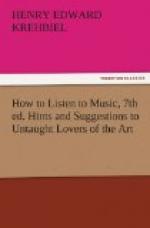[Sidenote: Serenades.]
[Sidenote: The Serenade in Shakespeare.]
A form which is variously employed, for solo instruments, small combinations, and full orchestra (though seldom with the complete modern apparatus), is the Serenade. Historically, it is a contemporary of the old suites and the first symphonies, and like them it consists of a group of short pieces, so arranged as to form an agreeable contrast with each other, and yet convey a sense of organic unity. The character of the various parts and their order grew out of the purpose for which the serenade was originated, which was that indicated by the name. In the last century, and earlier, it was no uncommon thing for a lover to bring the tribute of a musical performance to his mistress, and it was not always a “woful ballad” sung to her eyebrow. Frequently musicians were hired, and the tribute took the form of a nocturnal concert. In Shakespeare’s “Two Gentlemen of Verona,” Proteus, prompting Thurio what to do to win Silvia’s love, says:
“Visit by night your
lady’s chamber window
With some sweet concert:
to their instruments
Tune a deploring dump; the
night’s dread silence
Will well become such sweet
complaining grievance.”
[Sidenote: Out-of-doors music.]
[Sidenote: Old forms.]
[Sidenote: The “Dump."]
[Sidenote: Beethoven’s Serenade, op. 8.]
It was for such purposes that the serenade was invented as an instrumental form. Since they were to play out of doors, Sir Thurio’s musicians would have used wind instruments instead of viols, and the oldest serenades are composed for oboes and bassoons. Clarinets and horns were subsequently added, and for such bands Mozart wrote serenades, some of which so closely approach the symphony that they have been published as symphonies. A serenade in the olden time opened very properly with a march, to the strains of which we may imagine the musicians approaching the lady’s chamber window. Then came a minuet to prepare her ear for the “deploring dump” which followed, the “dump” of Shakespeare’s day, like the “dumka” of ours (with which I am tempted to associate it etymologically), being a mournful piece of music most happily characterized by the poet as a “sweet complaining grievance.” Then followed another piece in merry tempo and rhythm, then a second adagio, and the entertainment ended with an allegro, generally in march rhythm, to which we fancy the musicians departing. The order is exemplified in Beethoven’s serenade for violin, viola, and violoncello, op. 8, which runs thus: March; Adagio; Minuet; Adagio with episodic Scherzo; Polacca; Andante (variations), the opening march repeated.




